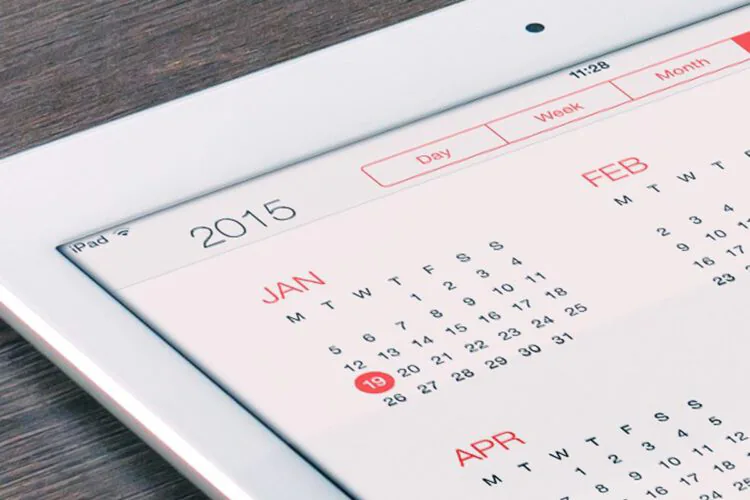Appealing mobile app design and navigation is a sure way to stand out in a saturated marketplace. Mobile app design has rapidly evolved since the first iPhone was released. In this article, we will chart the evolution of app design up to present day and attempt to predict the future of app design.

The past
Apps have come a long way since Steve Jobs launched the App Store in back in 2008. Many of these initial apps, as some of you may remember, focused on skeuomorphism. Skeuomorphism is a design concept which represents items as their real life counterparts. Thinking back to the earliest apps released in Apple App Store, such as the original Apple Newsstand, set up to look like a shelf of newspapers. Or the Notes app designed to look like a lined notebook with leather binding. This initial transition to mobile required a design that eased users into the world of mobile, by creating a design that attempted to emulate real life.
The top apps from 2008 included some familiar names such as Texas Hold’em, Facebook and Shazam, however, the 2008 version of these apps look considerably different to today’s versions. If we think about the original Facebook app, it is easy to see how mobile app design has changed. The 2008 version used a 3D design that gave users new to a touch screen, an experience more akin to the real life motion of pushing a button. These raised buttons and side bars seem a distant memory in comparison to the 2016 version.

The present
In recent years, mobile app design has moved away from skeuomorphism to flat design. Flat design refers to two-dimensional approach, which favours functionality and user experience. The introduction of flat design shifted the focus to minimalism, something which has continued to rise in popularity in all aspects of design, from mobile interfaces to interiors. Flat design focuses on clean, crisp user interfaces, substituting obvious ques for simplistic design. The comparison between the original Facebook app and the current, demonstrates this shift. 3D style buttons are replaced with flat images and text is kept to a minimum. Another clear example of the shift to flat design is shown in the various versions of the popular City Mapper app. . As the images above show, the original design focused on elevated buttons whereas by version 3.0 the design is flat.
Google also released their own design guidelines in 2014, Material design. In many ways, Google’s Material design is about adding back the depth which is removed in flat design. Elements such as responsive animations and transitions and lighting and shadow effects are all included in Google’s take on design.
The Flat design trend continues to change and grow, finding inventive ways of displaying functionality through minimalism. ‘Inspiration Fridays’ have become a ritual at Red C, here our in-house design team select examples of design interfaces that have inspired them. Below are a selection of recent picks from the design team, showcasing current design trends. These include designs that continue to emphasise flat design and others that are even moving away. For example, full screen imagery has increasingly dominated app design over text. The use of photography in the Louboutin restaurant app below, shows that imagery can be used to restore depth and interest to flat design. Solid colour palettes that fill whole screens are a move away from the traditional white space that often dominates flat design. Animations have also gained popularity, as a consequence perhaps of the rising popularity of GIFS. But animation is not just for entertainment, more and more apps are featuring animations that are meaningful, responsive and ultimately functional. Apple’s live blur has also helped to add depth to flat design, through blurring backgrounds whilst retaining focus on foreground elements, whether these are animations or notifications.


The future: how to design apps
Whilst flat design still continues to dominate, the addition of new screen sizes and wearable tech will mean that mobile app design trends will be constantly refined. As the past few years have shown this refinement is often a steady process. The evolution of screen sizes from the Apple watch to the iPhone 6 Plus, poses challenges over how design in the future will be converted over various screens. The popularity of minimalism also begs the question: how minimal can something become before it loses its functionality entirely? The introduction of Apple’s 3D touch on the iPhone 6S might be a way to solve this. Apple’s 3D touch is based upon the amount of pressure you apply to the display, with additional of functionalities like ‘Peek and Pop’. These new gestures could mean that if Apple’s 3D touch is to be rolled out on across all devices, then app design in the future could eventually do away with surplus menus and buttons. Extending the trend for minimalism whilst also retaining functionality. These may only be predictions, but one thing we can say for certain is that the future of mobile app design will bring new challenges and in turn innovative solutions.
Here at Red C, we are obsessed with design and believe that outstanding, intuitive User Experience (UX) and User Interface (UI) design lay the foundation for a successful digital product. Get in touch today for a free quote.
Contact georgia@red-c.co.uk for enquiries.



